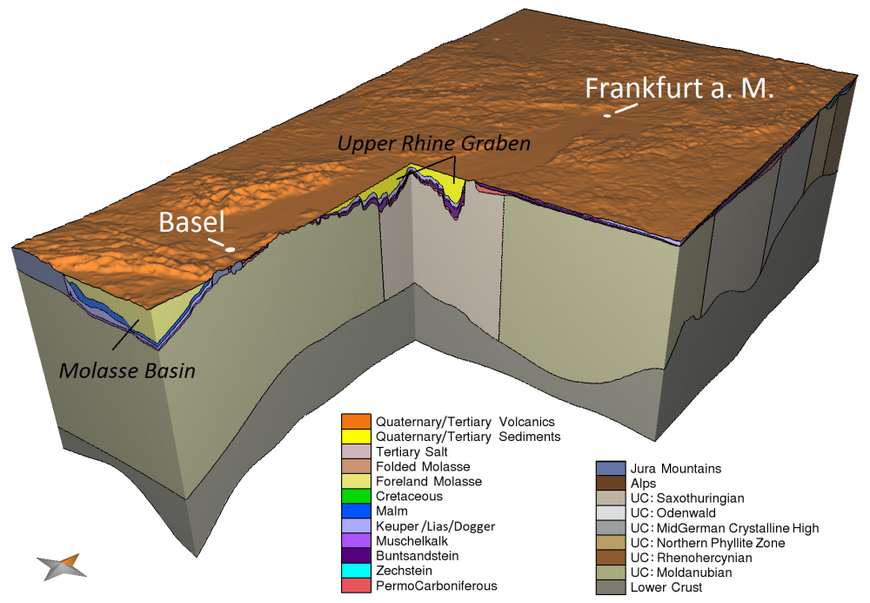Lithospheric-scale 3D structural and thermal modelling of the Upper Rhine Graben
The Upper Rhine Graben is a tectonically active rift system that developed as part of the European Cenozoic Rift System. The basin accommodated a thick package of sediments, which nowadays hosts a significant potential for geothermal energy. In order to utilise this energy resource, it is crucial to understand the temperature distribution and the influence of heat transport mechanisms (including groundwater flow) in the subsurface.
As part of the EU-funded project “IMAGE” (Integrated Methods for Advanced Geothermal Exploration), we aim to contribute to the development of an integrated and multidisciplinary approach for the exploration of geothermal reservoirs by understanding the processes and properties controlling the spatial distribution of key parameters (e.g. temperature) for geothermal exploration. Therefore, we first build a 3D structural model of the Upper Rhine Graben and adjacent areas, which considers all available geophysical and geological information and involves the main geological units in the whole lithosphere.
The 3D structural model is mainly based on Hessen3D a model developed by the TU Darmstadt in cooperation with the Hessian Agency for the Environment and Geology (HLUG). This 3D structural model images the geometries of the main sedimentary units of the subsurface of the northern Upper Rhine Graben. In addition, we have access to the 3D model GeORG, which covers the Upper Rhine Graben to the south. GeORG was developed as part of the same-titled EU-project by a collaboration of the State Office for Geology, Raw Materials and Mining of Baden-Wuerttemberg (LGRB), the French geological survey (BRGM), the State Office for Geology und Mining of Rhineland-Palatinate (LGB) and the Institute for Engineering and Environment Geology of Basel University. Furthermore, seismic reflection profiles (DEKORP project) give insights into the structure of the crystalline crust. These profiles are the basis for a combined approach of isostatic calculations and 3D gravity modelling to derive the density variations in the crystalline crust and the thicknesses of the upper and lower crust. The lithospheric thickness of the area originates from published seismological studies.
In a next step, the lithospheric-scale structural model serves for the calculation of the 3D conductive thermal field while taking into account the lithology-dependent rock properties radiogenic heat production and thermal conductivity. For the parameterisation of the thermal models laboratory measurement values can be used. Moreover, measured temperatures from deep wells can be employed for the validation of the predicted temperatures. Therefore, the final lithospheric-scale 3D conductive thermal model will be able to evaluate the geothermal potential also in areas where no temperature measurements are accessible. Furthermore, it forms the basis for smaller-scale 3D numerical simulations of coupled fluid and heat transport that need reliable boundary and initial conditions. Such numerical simulations allow an even more precise risk estimation for geothermal utilisation.
Funding:
IMAGE – Integrated Methods for Advanced Geothermal Exploration
This project has received funding from the European Union's Seventh Programme for research, technological development and demonstration under grant agreement No: 608553
More information about IMAGE (http://www.image-fp7.eu)
Publications:
Freymark, J.; Sippel, J.; Scheck-Wenderoth, M.; Bär, K.; Stiller, M.; Fritsche, J.-G. & Kracht, M. (2017): The deep thermal field of the Upper Rhine Graben (Tectonophysics, Vol. 694, p. 114-129, doi: 10.1016/j.tecto.2016.11.013)
Freymark, J.; Sippel, J.; Scheck-Wenderoth, M.; Bär, K.; Stiller, M.; Fritsche, J.-G. & Kracht, M. (2016): The thermal field of the Upper Rhine Graben – Temperature predictions based on a 3D model (Proceedings European Geothermal Congress 2016, Strasbourg, France, 19-23 September 2016)
Freymark, J.; Sippel, J.; Scheck-Wenderoth, M.; Bär, K.; Stiller, M.; Kracht, M. & Fritsche, J.-G. (2015): Heterogeneous Crystalline Crust Controls the Shallow Thermal Field – A Case Study of Hessen (Germany) (Energy Procedia, Vol. 76, p. 331-340, doi: 10.1016/j.egypro.2015.07.837)



